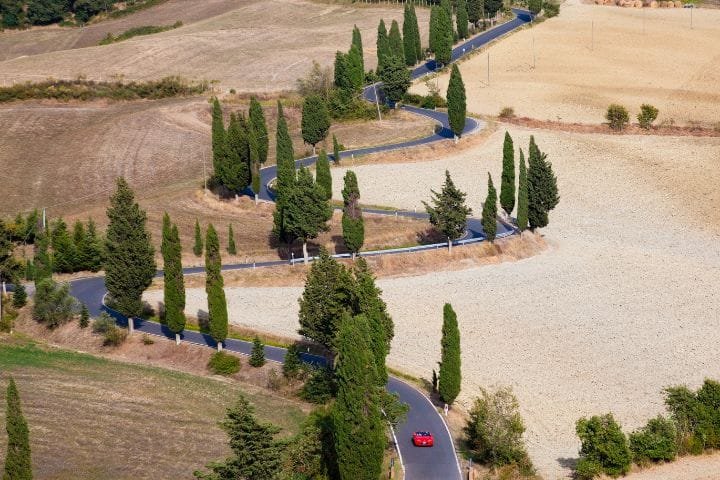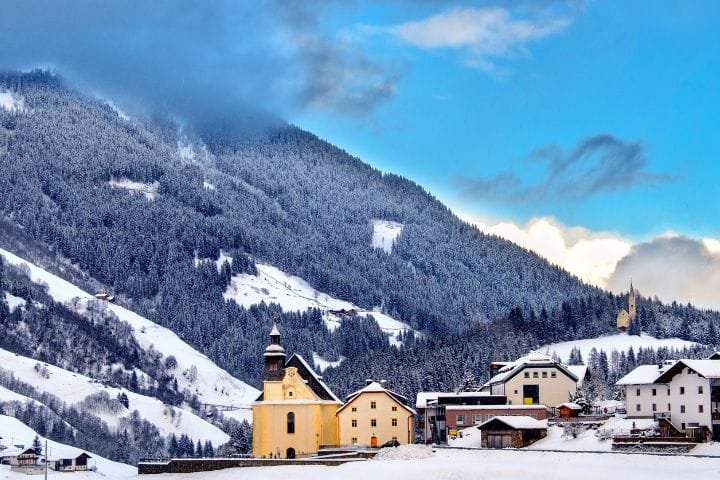Italian Roundabouts Guide: How to Navigate Like a Local

by Abu | Last Updated December 11, 2025

Mamma mia! As someone who learned to drive in Rome twenty years ago and has been navigating Italian roundabouts ever since, I can tell you that these traffic circles cause more panic among foreign drivers than any other aspect of Italian roads.
I’ve watched countless tourists freeze in terror at the entrance to a simple roundabout, while Italian drivers zip around them with balletic precision born from decades of practice.
The real secret to mastering Italian roundabouts lies in understanding that they’re not just traffic management tools – they’re social spaces where Italian driving culture reveals itself most clearly.
When you know how to read the subtle signals, anticipate other drivers’ intentions, and follow the unofficial etiquette that makes everything flow smoothly, you’ll discover that Italian roundabouts are actually more efficient and less stressful than the traffic light intersections that dominate other countries.
Let’s break down this Italian roundabouts guide step-by-step, starting with the fundamental rules that will transform you from a nervous tourist into a confident local navigator.

Understanding Italian Roundabout Basics: Rules and Regulations
Allora, let me start with the fundamental truth about Italian roundabouts – after years of driving in this country, from my first terrifying experience at a Roman traffic circle to now confidently navigating the most complex intersections, I can tell you that these aren’t the chaotic free-for-alls they appear to be. There are actual rules, and understanding them is your first step to roundabout mastery.
The official traffic law is simple: traffic already in the roundabout has absolute right-of-way over vehicles entering. This means you must yield to any car circulating, regardless of where they’re going or how they’re positioned. It sounds straightforward, but Italian implementation involves subtleties that catch foreign drivers off guard.
Roundabout types vary significantly throughout Italy. Single-lane circles in small towns operate differently than multi-lane monsters in Milan or Rome. The basic principle remains the same, but lane discipline, speed expectations, and local customs change dramatically based on size and location.
Traffic signs around Italian roundabouts use standard European symbols, but local road markings provide crucial information about lane usage and permitted movements. White arrows painted on asphalt indicate allowed directions from each lane, while dashed lines show where lane changes are permitted within the circle.
Speed considerations are critical for safe navigation. Approach speeds should allow complete stops if necessary, while circulation speeds must match traffic flow without blocking other drivers. Too slow creates dangerous backups, too fast prevents safe exits.
Emergency procedures within roundabouts require special awareness because stopped vehicles create hazards for circulating traffic. If you break down, try to exit immediately or signal distress clearly while moving to the outside edge of the circle.
- Traffic in a roundabout always has the right-of-way – this is absolute and non-negotiable
- Read road markings carefully – arrows and lane indicators provide crucial navigation information
- Match speeds to traffic flow – too slow or too fast creates dangerous situations
🚗 Master the Rules Before Entering a Roundabout
Understand the fundamentals so you can navigate confidently and avoid fines.
- Start with Italy’s complete driving laws & etiquette → Driving in Italy: Routes, Tips & Regulations
- Learn every essential road sign used at roundabouts → Italian Road Signs Explained
- Know the speed limits that apply before and after roundabouts → Speed Limits in Italy for Tourists
Italian Roundabout Etiquette: The Unwritten Rules

Here’s where Italian roundabouts become truly cultural experiences rather than simple traffic management. The unwritten rules govern how traffic actually flows, and understanding these customs transforms stressful encounters into smooth interactions.
Driver communication in Italian roundabouts is an art form that involves positioning, timing, and subtle signals indicating intentions before official turn signals are activated. Experienced drivers read these patterns instinctively, while foreign drivers miss the communication entirely.
Lane courtesy involves understanding when to create space for merging vehicles, when to maintain position firmly, and how to negotiate lane changes through mutual cooperation rather than aggressive competition. Italians generally cooperate when signals are clear and reasonable.
Local customs vary significantly by region. Northern Italian roundabouts tend to be more structured and Germanic in their precision, while southern circles embrace flexibility and creative interpretation. Rome represents chaos theory applied to traffic management, but it actually works when you understand the underlying patterns.
Rush hour patterns reveal Italian roundabout culture at its most intense. Morning and evening commuters develop efficient traffic flows that accommodate regular users while showing patience for occasional tourists who slow down established rhythms.
Tourist considerations show Italian drivers at their most accommodating. When they recognize foreign license plates or obviously confused drivers, locals often provide extra space and patience, though this courtesy has limits when safety becomes compromised.
Common courtesy in Italian roundabouts emphasizes maintaining smooth flow for everyone rather than individual advantage. Blocking intersections, cutting off other drivers, or failing to signal creates disorders that affect dozens of vehicles and generate legitimate anger.
- Learn to read subtle driver signals – positioning and timing communicate intentions before turn signals
- Show courtesy to confused drivers – Italians appreciate it when foreigners try to follow local customs
- Maintain traffic flow – smooth circulation benefits everyone more than individual advantage
🚘 Italian Driving Culture: What Locals Expect
Beyond regulations — learn the informal habits that shape real road behavior.
- Understand Italy’s driving culture & local etiquette → Understanding Driving Culture in Italy
- Don’t get surprised by hidden ZTL restrictions near intersections → How to Avoid ZTL Zones in Italy
Entering Italian Roundabouts: Approach and Entry Strategies

Approaching Italian roundabouts requires advanced planning because lane selection before entry determines your circulation options. Once you’re in the wrong lane, correction becomes difficult or impossible without creating dangerous situations.
Approach positioning depends on your intended exit and the roundabout’s lane configuration. Generally, right lanes serve right turns and straight movements, left lanes handle left turns and U-turns, but road markings provide definitive guidance that overrides general rules.
Yield protocols seem simple, but require judgment about gap sizes, acceleration capabilities, and traffic flow patterns. Italian drivers expect decisive action – hesitation at entry points creates dangerous situations because following vehicles anticipate consistent movement.
Gap assessment involves understanding that Italian traffic flows at higher speeds than many countries, requiring larger gaps for safe entry. Don’t attempt to squeeze into spaces that require other drivers to brake significantly.
Speed management during approach and entry should allow for smooth acceleration to match circulating traffic without forcing speed adjustments from other drivers. Practice coordinating slowdown for yield assessment with acceleration for gap utilization.
Signal usage for roundabout entry follows specific protocols – indicate right when exiting, left when continuing past the first exit, and no signal when going straight through simple intersections. Clear signaling helps other drivers predict your movements.
Common entry mistakes include stopping when gaps exist, entering too slowly, and forcing traffic to brake, choosing the wrong lanes for intended destinations, and failing to signal intentions clearly for other drivers.
- Choose lanes before reaching the roundabout – last-minute changes create dangerous situations
- Enter decisively when safe gaps appear – hesitation disrupts traffic flow and creates hazards
- Signal intentions clearly – other drivers need to predict your planned movements
Plan Your Trip with Our Favorite Booking Tools
Navigating Multi-Lane Italian Roundabouts: Advanced Techniques

Multi-lane roundabouts represent Italian traffic engineering at its most complex, requiring advanced skills and cultural understanding that separates confident drivers from nervous tourists struggling with every intersection.
Lane selection strategies involve understanding that inner lanes generally serve longer routes around the circle, while outer lanes facilitate shorter journeys and exits. However, local traffic patterns and road markings override general principles.
Lane changing within roundabouts is legal but requires exceptional care and clear communication. Signal intentions early, check blind spots carefully, and ensure receiving lanes have adequate space before maneuvering. Never force lane changes that require other drivers to brake.
Complex intersections with multiple approaches and exits create challenging navigation scenarios where GPS systems sometimes provide inadequate guidance. Understanding lane markings and advanced signs becomes crucial for proper positioning.
Truck and bus interactions require special awareness because large vehicles need extra space for turning and may not see smaller cars in their blind spots. Give commercial vehicles priority and extra clearance, especially during tight maneuvers.
Motorcycle awareness is critical in Italian traffic because two-wheelers often occupy spaces between cars and may appear suddenly in gaps. Check mirrors constantly and leave extra space for motorcycles filtering through traffic.
Peak traffic management in busy urban roundabouts involves reading traffic flow patterns, anticipating congestion points, and positioning for optimal progress without blocking other movements. Experienced drivers develop an intuitive understanding of traffic rhythms.
- Understand lane purposes – inner lanes for longer routes, outer lanes for quick exits
- Give commercial vehicles extra space – trucks and buses need room for wide turning movements
- Watch constantly for motorcycles – two-wheelers appear in unexpected spaces
Exiting Italian Roundabouts: Timing and Technique
Exiting Italian roundabouts smoothly requires precise timing, clear signaling, and awareness of pedestrians and other vehicles that may be using the same exit point simultaneously.
Exit preparation should begin well before your intended departure point, especially in multi-lane roundabouts where lane changes require advance planning. Position yourself in appropriate lanes and signal intentions clearly for following traffic.
Lane discipline means maintaining your chosen lane until the exit point rather than cutting across multiple lanes at the last moment. Other drivers expect consistent positioning and may not accommodate sudden lane changes.
Acceleration patterns for exiting should match the flow of traffic leaving the roundabout while checking for pedestrians, cyclists, or vehicles that may be stopped or moving slowly in the exit lane.
Pedestrian awareness becomes crucial at roundabout exits because many intersections include crosswalks immediately after the circle. Italian pedestrians often walk assertively, expecting drivers to yield appropriately.
Signal timing for exits should begin as you pass the exit preceding your intended departure, giving other drivers adequate notice of your intentions. Cancel signals promptly after completing exits to avoid confusing following traffic.
Common exit errors include late signaling, cutting across lanes, failing to check for pedestrians, accelerating too aggressively into exit traffic, and forgetting to cancel turn signals after completing movements.
- Signal before reaching your exit – other drivers need advance notice of your intentions
- Check for pedestrians carefully – crosswalks often follow immediately after roundabout exits
- Cancel signals promptly – continuing indicators confuse other drivers about your intentions
Regional Variations: Roundabout Customs Across Italy
Italian roundabout behavior varies significantly by region, reflecting local driving cultures and traffic management philosophies that range from Germanic precision in the north to creative flexibility in the south.
Northern Italy roundabouts around Milan, Turin, and the Alpine regions tend to follow rules more strictly, with organized lane discipline and predictable traffic patterns. Drivers signal clearly, maintain consistent speeds, and generally accommodate tourists struggling with navigation.
Central Italy traffic circles, especially around Rome and Florence, represent organized chaos where official rules provide a basic framework but local customs govern actual behavior. Roman roundabouts require confidence and assertiveness to navigate successfully.
Southern Italy roundabouts embrace flexibility and creative interpretation, where rules provide suggestions rather than absolute requirements. Naples, Sicily, and Calabrian traffic circles reward adaptability and patience over rigid rule-following.
Urban versus rural differences are significant throughout Italy. City center roundabouts handle heavy traffic with aggressive efficiency, while countryside circles operate more casually with greater tolerance for uncertainty and mistakes.
Tourist area considerations around major attractions often involve modified behavior patterns where locals show extra patience for confused visitors, though this courtesy has limits when safety becomes compromised.
Local driver personalities reflect regional cultural differences – northern precision, central creativity, southern passion – but all Italian drivers share expectations about communication, courtesy, and traffic flow maintenance.
- Adapt to regional styles – northern precision differs significantly from southern flexibility
- Urban roundabouts demand confidence – city traffic moves faster with less tolerance for hesitation
- Tourist areas show extra patience – locals accommodate confused visitors within safety limits
🌍 Driving Habits Differ Across Regions
From northern discipline to southern improvisation — know what to expect.
- Understand how regional road culture affects driving → Driving Culture & Road Etiquette in Italy
- Review climate-related driving differences →
→ Driving in Italy During Summer Heatwav
→ Essential Winter Driving Tips
Common Mistakes and How to Avoid Them
Tourist traps in Italian roundabouts follow predictable patterns that create dangerous situations for both foreign drivers and local traffic trying to accommodate confused visitors.
Signaling mistakes represent the most common errors, including failing to signal exits, signaling too late for other drivers to react appropriately, or continuing to signal after completing movements and confusing following traffic.
Lane violations involve entering roundabouts in the wrong lanes for intended destinations, changing lanes unsafely within circles, or cutting across multiple lanes at exit points without adequate clearance or warning.
Speed errors include approaching too fast and missing entry opportunities, entering too slowly and forcing traffic to brake, or circulating at speeds that don’t match traffic flow and create dangerous speed differentials.
Yield failures happen when drivers misunderstand right-of-way rules and enter roundabouts without adequate gaps, forcing circulating traffic to brake or swerve to avoid collisions.
Recovery techniques for mistakes involve staying calm, signaling clearly, and taking extra circulation loops if necessary to correct positioning rather than forcing dangerous moves that create accidents.
Prevention strategies include advanced route planning, understanding local customs, practicing in low-traffic areas, and accepting that occasional mistakes are normal parts of learning Italian traffic patterns.
- Signal clearly and consistently – other drivers depend on accurate information about your intentions
- Take extra loops if confused – circulating again is safer than forcing dangerous corrections
- Stay calm when mistakes happen – panic creates more dangerous situations than initial errors
⚠️ Avoid These Tourist Mistakes
The issues most visitors run into — and how to prevent them.
- Misreading Italian road signs is the #1 mistake → Italian Road Signs Explained
- Entering incorrect lanes or speeding near roundabouts → Speed Limits in Italy for Tourists
• Accidentally entering a nearby ZTL →
ZTL Zones Explained
Practical Tips for Confident Roundabout Navigation
Preparation strategies begin long before approaching roundabouts through route planning, understanding local traffic patterns, and mental rehearsal of complex intersections that appear along your planned journey.
Technology aids include GPS settings that provide lane guidance for complex roundabouts, though local road markings and signs provide more reliable information than navigation systems that may not reflect recent changes.
Passenger communication involves designating co-pilots for navigation assistance, establishing clear communication protocols, and ensuring passengers understand their roles in complex traffic situations.
Stress management techniques help maintain focus and decision-making ability during challenging roundabout encounters. Deep breathing, positive self-talk, and accepting that learning takes time reduce anxiety that impairs driving performance.
Practice opportunities exist throughout Italy in smaller towns and off-peak hours when traffic density allows experimentation with roundabout techniques without pressure from impatient local drivers.
Emergency contacts should include rental car companies, insurance providers, and local emergency services, though most roundabout problems involve navigation confusion rather than mechanical failures.
Confidence building happens gradually through successful experiences, understanding local customs, and developing an intuitive feel for Italian traffic patterns that makes roundabout navigation feel natural rather than stressful.
- Practice during off-peak hours – lighter traffic allows learning without pressure from other drivers
- Use passengers as navigators – clear communication helps with complex route planning
- Build confidence gradually – start with simple roundabouts before attempting complex urban intersections
🚗 Plan Smarter for Your Italy Road Trip
- Understand all Italian driving rules → Driving in Italy Guide
- Learn the symbols used on Italian roads → Italian Road Signs Explained
- Prevent ZTL fines while navigating cities → How to Avoid ZTL Zones
- Check speed limits before entering major intersections → Speed Limits in Italy
Conclusion
Mastering Italian roundabouts transforms you from a nervous tourist into a confident driver who can navigate Italy’s roads with the same ease and efficiency as locals who’ve been doing it their entire lives!
These traffic circles aren’t obstacles to fear – they’re elegant solutions that keep traffic flowing smoothly when you understand the rules, etiquette, and techniques that make them work so effectively.
As someone who has navigated thousands of Italian roundabouts over two decades, I can promise you that the initial intimidation gives way to appreciation for their efficiency once you master the essential skills.
The key to roundabout success lies in preparation, observation, and practice. Remember that learning Italian roundabout navigation is part of a larger cultural education about how Italians approach shared spaces, social cooperation, and collective problem-solving.
The same principles that make roundabouts work – clear communication, mutual respect, and shared responsibility for group success – apply throughout Italian society and enhance every aspect of your travel experience.
Don’t expect perfection immediately. Even experienced Italian drivers occasionally make mistakes or encounter situations that require creative solutions. With proper preparation and the techniques outlined in this guide, you’ll soon be navigating Italian roundabouts with confidence and skill that rivals any local driver.
Buona strada e navigazione perfetta! Good roads and perfect navigation! Andiamo a conquistare le rotonde italiane con sicurezza!
FAQs on Italian Roundabouts Guide
Who has the right-of-way in Italian roundabouts?
Traffic already circulating in the roundabout always has absolute right-of-way over vehicles entering. You must yield to any car already in the circle, regardless of its destination or lane position.
This is the fundamental rule that governs all Italian roundabout navigation – when in doubt, yield to traffic already circulating.
Which lane should I use when entering an Italian roundabout?
Choose your lane based on your exit destination: right lanes for right turns and straight ahead, left lanes for left turns and U-turns. However, always follow the white arrows painted on the road surface and overhead signs, as these override general rules.
Lane selection must happen before reaching the roundabout – last-minute changes create dangerous situations.
When should I signal at Italian roundabouts?
Signal right when exiting the roundabout, starting as you pass the exit before your intended departure point. Don’t signal when entering unless turning left for longer routes around the circle.
Cancel your signal immediately after exiting to avoid confusing other drivers about your next intentions.
What’s the biggest mistake tourists make in Italian roundabouts?
Hesitating at entry points when safe gaps are available – this disrupts traffic flow and creates dangerous backup situations. Italian drivers expect decisive action once you’ve assessed the gap.
Other common mistakes include wrong lane selection, late signaling, and stopping unnecessarily when traffic is flowing smoothly.
Are Italian roundabouts really more dangerous than those in other countries?
No, Italian roundabouts are actually safer than traffic light intersections when navigated properly – they just require understanding local customs and confident driving.
The key is learning to read traffic patterns, communicate clearly with other drivers, and follow the unwritten etiquette that makes these circles flow efficiently. Practice during off-peak hours to build confidence.
Do Italian roundabouts have the same rules as in other countries?
Not always. In Italy, you generally yield to traffic already inside the roundabout, but signs can vary. Always watch for yield signs and road markings.
What should I do if I miss my exit in a roundabout?
Don’t panic! Simply stay in the roundabout and go around again until you reach your exit. Stopping inside the roundabout is dangerous and not allowed.
💬 We’d love to hear from you!
Have questions, tips, or personal travel stories to share? Drop them in the comments below — your insights help fellow travelers plan their adventures too.













